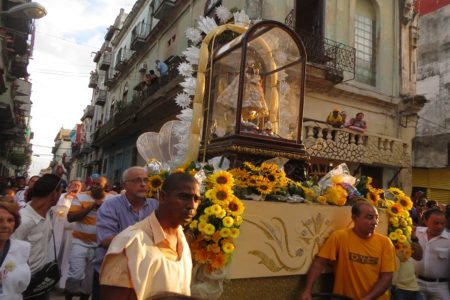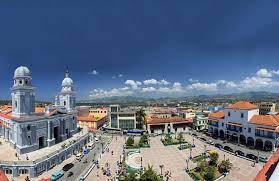“CACHITA”, LA CARIDAD DEL COBRE PARA LOS CUBANOS ES UN OASIS DE RECONCILIACION Y ARMONIA. PHOTOS
Desde tiempos inmemorables en cada hogar de Cuba se puede ver un cuadro o una reliquia con la imagen de una bella virgencita. La imagen representa la Virgen María Santísima con un Niño Jesús en sus brazos y una cruz.
La imagen original, la misma que fue encontrada en los mares al norte de Oriente hace ya más de 400 años, se encuentra actualmente y se venera en la Basílica Santuario Nacional de Nuestra Señora de la Caridad del Cobre en Santiago de Cuba.
Es destino de la peregrinación de miles de creyentes que acuden diariamente a venerar la virgen e implorar sus favores y bendiciones.
En la oración a la Virgen de la Caridad del Cobre, colocada por el Papa Francisco en la peregrinación al Santuario Nacional, se ruega a la Madre de Cristo, que “vino a visitar nuestro pueblo, y quiso quedarse con nosotros como Madre y Señora de Cuba, a lo largo de su peregrinar por los caminos de la historia”.
En esa misma oración, se sustituyen las apelaciones a la Caridad de Cobre, o a la Patrona de Cuba, y se la llama, con toda propiedad, “Madre de todos los cubanos”, “signo de esperanza y centro de comunión fraterna”.
Luego, se alude a los que están dentro y fuera de la Isla, y se le pide a la Virgen que interceda por nosotros, “con tu corazón maternal”. También se pide que acreciente nuestra fe, avive la esperanza, aumente y fortalezca en nosotros el amor.
Más adelante se lee, en consonancia con el espíritu maternal de la Patrona de Cuba: “Ampara nuestras familias, protege a los jóvenes y a los niños, consuela a los que sufren”.
Para concluir la oración, se apela a la Virgen como Madre de la reconciliación, y se le pide que reúna a su pueblo disperso por el mundo, y haga de la nación cubana un hogar de hermanos y hermanas.
Las menciones a la Caridad del Cobre, en tanto Madre de todos los cubanos, se relacionan con una larga tradición que se remonta a la primera aparición, en 1612, en la Bahía de Nipe, a tres esclavos muy humildes, de raza negra e india.
ORIGEN DE NUESTRA VIRGEN DEL COBRE…
Según cuenta la tradición, la imagen de la Virgen con el Niño Jesús en brazos –la misma imagen que hoy es objeto de veneración por los cubanos– se acercaba flotando en una tabla, donde podía leerse la frase Yo soy la Virgen de la Caridad.
A través del sincretismo religioso, la Virgen de la Caridad conserva su aura maternal. Los yorubas la identificaron con Oshún que es la dueña del cobre, es protectora de las parturientas y tenía fama de caritativa y misericordiosa. La Iglesia católica también utilizó la imagen en cintas de raso para proteger a las mujeres embarazadas y en el parto.
Durante las guerras de independencia de Cuba, las tropas del Ejército Libertador manifestaban gran devoción por la Virgen de la Caridad y se encomendaban a ella. En la actualidad, las personas que visitan el Santuario suelen volver a sus hogares con diminutas piedras de cobre. Se dice que quienes las poseen cuentan con una especial protección para ellos y sus familias.
La Virgen es una de las figuras más preciadas de la isla, representando la esperanza y la salvación ante la desgracia. Con el tiempo, La Cachita “se ha convertido en un símbolo por excelencia de la identidad cubana”. Ella une tanto a aquellos en casa como en el extranjero, a través de líneas de raza y clase. Dondequiera que se establecieron los inmigrantes cubanos, trajeron consigo su devoción por la Caridad.
Emilio Cueto señala los temas cristianos sugeridos por La Cachita: “Ella vino a Cuba con el mayor de los regalos, su propio hijo, y no se apareció a un sacerdote ni a un obispo, sino a hombres comunes. Ella habló no solo a los aborígenes, pero también a los españoles, criollos y esclavos africanos.
“CACHITA”, THE VIRGIN OF THE CARIDAD DEL COBRE, FOR THE CUBANS IS AN OASIS OF RECONCILIATION AND HARMONY. PHOTOS
Since time immemorial in every home in Cuba, you can see a painting or a relic with the image of a beautiful virgin. The image represents the Blessed Virgin Mary with a Child Jesus in her arms and across.
The original image, the same one that was found in the seas to the north of Oriente more than 400 years ago, is currently found and venerated in the Basilica Santuario Nacional de Nuestra Señora de la Caridad del Cobre in Santiago de Cuba.
It is the destination of the pilgrimage of thousands of believers who come daily to venerate the Virgin and implore her favors and blessings.
In the prayer to the Virgen de la Caridad del Cobre, placed by Pope Francis on the pilgrimage to the National Shrine, the Mother of Christ is prayed to, who “came to visit our town, and wanted to stay with us as Mother and Lady of Cuba, throughout its pilgrimage along the paths of history”.
In that same sentence, the appeals to Caridad de Cobre, or the Patron Saint of Cuba, are replaced, and she is called, with all propriety, “Mother of all Cubans”, “sign of hope and center of fraternal communion”.
Then, reference is made to those who are inside and outside the Island, and the Virgin is asked to intercede for us, “with your maternal heart.” It is also asked to increase our faith, revive hope, and increase and strengthen love in us.
Further on it reads, in keeping with the maternal spirit of the Patron Saint of Cuba: “Help our families, protect young people and children, comfort those who suffer.”
To conclude the prayer, the Virgin is appealed to as the Mother of reconciliation, and she is asked to gather her people scattered throughout the world and make the Cuban nation home for brothers and sisters.
The mentions of Caridad del Cobre, as the Mother of all Cubans, are related to a long tradition that goes back to the first appearance, in 1612, in the Bay of Nipe, to three very humble slaves, black and Indian.
ORIGIN OF OUR VIRGIN OF EL COBRE…
According to tradition, the image of the Virgin with the Child Jesus in her arms – the same image that today is the object of veneration by Cubans – came floating on a board, where the phrase I am the Virgin of Charity could be read.
Through religious syncretism, the Virgen de la Caridad preserves her maternal aura. The Yorubas identified her with Oshún who is the owner of copper, she is the protector of women in labor and had a reputation for charity and mercy. The Catholic Church also used the image of satin ribbons to protect pregnant women and women in childbirth.
During the Cuban wars of independence, the troops of the Liberation Army showed great devotion to the Virgin of Charity and entrusted themselves to her. Nowadays, people who visit the Sanctuary usually return to their homes with tiny copper stones. It is said that those who own them have special protection for themselves and their families.
The Virgin is one of the most precious figures on the island, representing hope and salvation in the face of misfortune. Over time, La Cachita “has become a quintessential symbol of Cuban identity.” She unites both those at home and abroad, across lines of race and class. Wherever Cuban immigrants settled, they brought with them her devotion to her Charity.
Emilio Cueto points out the Christian themes suggested by La Cachita: “She came to Cuba with the greatest of gifts, her own son, and she did not appear to a priest or a bishop, but to common men. She spoke not only to the aborigines, but also to the Spanish, Creoles, and African slaves.
Agencies. CiberCuba. Joel del Río. Extractos. Excerpts. Internet Photos. Arnoldo Varona. www.TheCubanHistory.com
THE CUBAN HISTORY, HOLLYWOOD.










